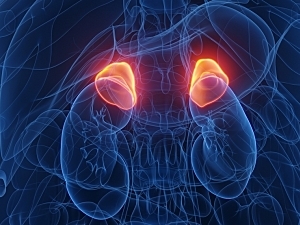Hypertensive women are more likely to display salt sensitivity of blood pressure than hypertensive men. A growing body of evidence suggests women secrete more aldosterone than men do and their adrenal glands are more sensitive to stimulation by secretagogues, such as angiotensin II. Furthermore, estrogen modifies target organ responses to activation of the mineralocorticoid receptor (MR).
One of the genes associated with hypertension is lysine-specific demethylase 1 (LSD1). In rodents, LSD1 levels are modified by the level of dietary salt intake, and LSD1 deficiency leads to inappropriate activation of the MR.
In two previous studies, LSD1 heterozygote knockout mice (LSD1+/−) displayed altered aldosterone secretion/MR activation in an age- and sex-dependent manner, and progression to hypertension was prevented with MR antagonism.
Researchers at Brigham and Women’s Hospital have now published data in the Journal of Endocrinology that reinforce those findings. Yi Jun Desmond Tan and Luminita H. Pojoga, PhD, of the Division of Endocrinology, Diabetes and Hypertension at the Brigham, and colleagues also report for the first time that even at the level of aldosterone biosynthesis, there is an effect of biological sex.
Methods
At age 18 weeks or 40 weeks, male and female LSD1+/− mice and wild-type littermates entered either:
- An in vivo study in which they were fed a liberal “Western diet” level of sodium intake for seven days, then had blood pressure measured
- An ex vivo study in which they were fed a high-sodium diet for seven days, then were euthanized for excision and mRNA analysis of the adrenal gland
Results
The key findings were:
- Among 18-week-old wild-type mice, female sex was associated with increased expression of enzymes involved early in aldosterone’s biosynthetic pathway, but circulating aldosterone levels or systolic blood pressure (SBP) did not differ by sex
- In both age groups of LSD1+/− mice, the entire aldosterone biosynthetic pathway was suppressed in females versus males, as well as versus wild-type mice
- Among 40-week-old mice, there was no difference between wild-type and LSD1+/− animals in the expression of the first three enzymes in the aldosterone biosynthesis pathway, but levels of the last enzyme were significantly elevated in male (and not female) LSD1+/− mice
- Among 18-week-old LSD1+/− mice, circulating aldosterone levels and SBP were significantly higher in males than females; in the older age group, aldosterone levels were significantly higher in females but SBP was significantly higher in males
- Statistical analyses showed significant sex/LSD1 genotype interactions in both age groups for all three phenotypes: aldosterone biosynthetic enzymes (the proximal phenotype), circulating aldosterone (the intermediate phenotype), and SBP (the distant phenotype)
Therapeutic Implications
These data provide insight into the roles of sex and LSD1 in the heterogeneity of hypertension and the possibility of providing more personalized treatment. MR antagonists may be an important therapeutic option.
The results may be especially important for older individuals of African or Hispanic/Latino ancestry. Previous research published in the American Journal of Hypertension showed that those who carry a particular LSD1 gene variant (rs587168) are particularly susceptible to salt-sensitive hypertension.
LSD1 inhibitors are in clinical trials, mainly for various cancers. This study suggests patients receiving them may need to be monitored for cardiovascular adverse effects.
